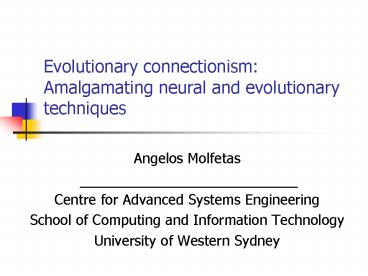Evolutionary connectionism: Amalgamating neural and evolutionary techniques - PowerPoint PPT Presentation
1 / 18
Title:
Evolutionary connectionism: Amalgamating neural and evolutionary techniques
Description:
Baldwin effect in evolutionary theory. Kun, Mak and Siu (2000) ... Evolutionary connectionism. Theory and operation. Solutions to Problems ... – PowerPoint PPT presentation
Number of Views:103
Avg rating:3.0/5.0
Title: Evolutionary connectionism: Amalgamating neural and evolutionary techniques
1
Evolutionary connectionism Amalgamating neural
and evolutionary techniques
- Angelos Molfetas
- Centre for Advanced Systems Engineering
- School of Computing and Information Technology
- University of Western Sydney
2
Initial pleasantries
- Details
- P.h.D research (1st year)
- Topic Evolutionary connectionism
- Research in the field
- Direction of my research
- Plan of action
- Basic concepts
- What constitutes as research in this field?
- Process of research
- Possible research topics
- Summary
3
Basic concepts
- Artificial Neural Networks (ANNs)
- Simplified imitation of biological neural
networks. - Synonyms Neural Networks, connectionist
networks. - Components Neurons, connection weights,
activation functions, learning rules, etc. - Types of learning Supervised training,
unsupervised training and reinforcement learning. - Used for classification, pattern recognition,
filtering and prediction.
4
Basic concepts
5
Basic concepts
- Genetic Algoritms (GAs)
- Using evolutionary principles to find solutions
(survival of the fittest) - Key points
- Population of solutions
- Solution characteristics encoded in genes
- GA Phases Evaluation, selection, crossover and
mutation
6
Combining neural and evolutionary computing
- Encode ANN characteristics into gene structures.
GA finds optimal ANN characteristics. - Motivation
- ANNs and GAs seem to work well together
- Imitate natures way
- Make ANNs simple to use
- Let the computer do the hard work.
7
What constitutes as research in this field?
- Introduce new algorithms or methods
- New architectures
- Genetic encoding schemes (mapping neural network
characteristics to gene structures) - Learning mechanisms
- Comparisons
- Comparisons within topic
- Comparisons with other techniques.
8
What constitutes as research in this field?
- Applying evolved ANNs to solve problems
- For e.g. Speech recognition
- Application of techniques to investigate
phenomena
9
Research topics
- GA based connection weight training
- Pendharkar and Rodger (1999)
- Comparisons to other learning techniques.
- Performance of different GA crossover operations.
- GA encoding schemes for ANNs
- Dasgupta and McGregor (1992)
- Encoding scheme sGA
- Types of characteristics encoded (weights and
structure) - Chalmers (1990)
- Encoding learning processes.
10
Research topics
- Application of evolved ANNs to problems
- Watts and Kasabov (1998)
- Phoneme recognition (Speech recognition)
- Harvey (1995)
- Robotics
- Game theory.
- Chellapilla and Fogel (1999), Chellapilla and
Fogel (2001). - IPD
- TIC-TAC_TOE
- CHECKERS
11
Research topics
- Investigating Phenomena
- Jones and Konstam (1999)
- Baldwin effect in evolutionary theory
- Kun, Mak and Siu (2000)
- Lamarckian Evolution in recurrent neural networks
12
Process of Research
- Experimental methodologies dominant research
method. - Comparisons
- Proof of concept
- Mathematical manipulation
- Draws from multiple disciplines
- Often problem driven
13
Direction of research
- Possible Research topics
- Evolutionary ANNs to extend Ambalavanan and
Carlos (1999) work. - Application of evolutionary ANNs to financial
problems. - Extend GA encoding schemes to incorporate more
characteristics. - Focus thesis on the techniques rather than their
application to a given problem domain
14
Quick Summary
15
Final note
- Leave you with one final thought
- Next wave of innovation Artificial Intelligence
and robotics
16
References
- Chellapilla, K., Fogel, D. (1999). Evolution,
Neural Networks, Games, and Intelligence.
Proceedings of the IEEE. - Chellapilla, K., Fogel, D. (2001). Evolving an
expert checkers playing program without using
human expertise. IEEE transactions on
evolutionary computation, 5(4), 422-428 - Chalmers, D. (1990). The Evolution of Learning An
experiment in Genetic Connectionism. Proceedings
of the 1990 Connectionist Models Summer School
(pp. 81-90). - Dasgupta, D., McGregor, D. (1992). Designing
application-specific neural networks using the
Structured Genetic Algorithm. COGANN-92
(International workshop on combinations of
Genetic Algorithms and Neural Networks)
17
References
- Harvey, Inman (1995). The artificial evolution of
adaptive behaviour. Unpublished thesis,
University of Sussex, Brighton - Jones, M., Konstam, A. (1999). The use of
genetic algorithms and neural networks to
investigate the Baldwin effect. Proceedings of
the 1999 ACM symposium on applied computing, pp.
275-279 - Kasabov, N., Watts, M. (1997). Genetic
algorithms for structural optimisation, dynamic
adaptation and automated design design of fuzzy
neural networks. Internation conference on Neural
Networks, 4, 2546-2549. - Ku, K., Mak, M., Siu, W. (2000). A study of the
lamarckian evolution of recurrent neural
networks. IEEE transactions on evolutionary
computation, 4 (1), 31 - 42
18
References
- Namasivayam, A., Carlo, W. (1999). Comparison
of the prediction of extremely low birth weight
neonatal mortality by regression analysis and by
neural networks. Society of Pediatric Research
meeting - Pendharkar, P., Rodger, J. (1999). An empirical
study of non-binary genetic algorithm-based
neural approaches for classification. Proceedings
of the 20th international conference on
Information Systems. - Watts, M., Kasabov, N. (1998). Genetic
Algorithms for the design of fuzzy Neural
Networks. Proceedings of ICONIP' 98 - The fifth
international conference on Neural Information
Processing.































